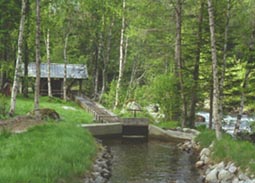Vadmal and other woollens
Kerstin Fröberg, Ingrid K Hanssen
The woollen fabric known as vadmal has a long history in the Scandinavian countries. The word vadmal means "a measure of length" and was used as a standard of value. Vadmal, according to literature from the 19th century, was woven in plain weave or twill and was woven very densely. Some sources say that two weavers were required and that they had to beat each pick eight to twelve times for "prime quality vadmal". The cloth was then pounded in a hammer mill for at least 8 hours, sometimes longer.According to modern knowledge vadmal is woven very openly - the fabric should look like cheesecloth on the loom - and it only needs 1-2 hours of treatment and nevertheless will come out as the same type of fabric. Since operating hammer mills are not so easily found anymore, weavers now tend to do their fulling of woollen cloth in the washing machine. Ingrid wanted to learn more about the difference between these methods and suggested that we find a hammer mill where we were allowed to treat the cloth ourselves. Theory is fine, but practice is better...



